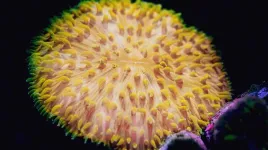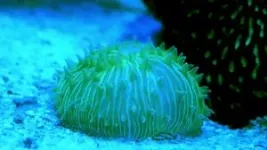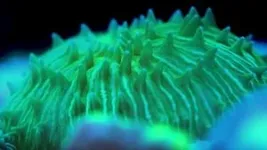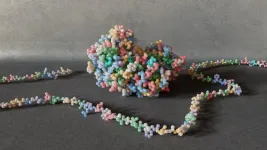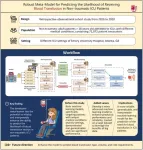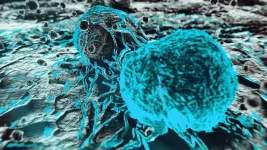(Press-News.org) When it comes time to migrate, QUT research has found how a free-living coral ignores the classic advice and goes straight towards the light.
The research – led by Dr Brett Lewis from the QUT School of Atmospheric and Earth Sciences and Reef Restoration and Adaptation Program, and published in PLOS One – investigated how the free-living mushroom coral Cycloseris cyclolites moves, navigates and responds to light in its natural environments.
“Not all corals are attached to the substrate; some are solitary and free-living, allowing them to migrate into preferred habitats,” Dr Lewis said.
“However, the lifestyle of these mobile corals, including how they move and navigate for migration, remains largely obscure.”
Cycloseris cyclolites is an adorably small free-living species of mushroom coral capable of migrating to different reef habitats, often driven by the search for optimal light conditions.
Using high-resolution time-lapse imaging, the team identified that Cycloseris cyclolites was able to move via a mechanism known as pulsed inflation, a process where the coral inflates and deflates its tissue in rhythmic bursts to propel itself forward, like the movement seen in jellyfish.
The mechanism appears to be a widespread strategy for free-living corals, aiding in functions such as self-righting when turned upside down, sediment rejection when buried during storms and now phototaxis – behaviours that help the coral survive in complex environments.
“Our findings suggest that pulsed inflation is not just a survival strategy but a critical mechanism for migration and navigation,” Dr Lewis said.
“The ability of Cycloseris cyclolites to move towards specific light sources is a fascinating parallel to other marine species like jellyfish, which suggests they are more neurologically sophisticated than previously thought.”
Cycloseris cyclolites was also shown to exhibit a strong preference for blue light, with 86.7 per cent of the corals moving towards blue light sources, compared to just 20 per cent for white light.
The ability of these migratory mushroom corals to distinguish between different wavelengths of light aligns with their preference for deeper water habitats, where blue wavelengths dominate, and could be crucial for their migration to optimal depths for survival, reproduction and dispersal.
Providing new insights into coral mobility mechanisms, the findings show just how closely related these corals are to jellyfish mechanisms which have been previously researched as a key point in the evolution of the centralised nervous system humans possess today.
“The findings also have important ecological implications,” Dr Lewis said.
“Understanding their movement strategies could help scientists predict how migratory corals might resist, survive or adapt to changes in environmental conditions such as sea surface changes caused by climate change, which can be reduced by the deeper waters these corals migrate to.
“With these climate-driven factors increasing, the faster the migration, the higher the chance of survival.”
Other QUT researchers involved in the study include Professor Peter Prentis, from the School of Biology and Environmental Science, and Dr Luke Nothdurft, from the School of Atmospheric and Earth Sciences.
END
Float like a jellyfish: New coral mobility mechanisms uncovered
2025-01-22
ELSE PRESS RELEASES FROM THIS DATE:
Severe weather and major power outages increasingly coincide across the U.S.
2025-01-22
An understanding of the relationship between severe weather and power outages in our changing climate will be critical for hazard response plans, according to a study led by a researcher at Columbia University Mailman School of Public Health. The study is published in the open-access journal PLOS Climate.
Throughout the U.S., large-scale power outages commonly occur alongside severe weather events. These combined events can be associated with major economic costs and health risks, as loss of power can disrupt medical equipment, heating or air conditioning, and other important systems. As severe weather events increase in severity and frequency ...
Who to vaccinate first? Penn engineers answer a life-or-death question with network theory
2025-01-22
Engineering and medical researchers at Penn have developed a groundbreaking framework that can determine the best and most computationally optimized distribution strategy for COVID-19 vaccinations in any given community. Published in PLOS One, this study addresses one of the most critical challenges in pandemic response — how to prioritize vaccination efforts in communities with individuals of different risk levels when supplies are scarce and the stakes are high.
The research team, comprised of Saswati Sarkar, Professor ...
Research shows PTSD, anxiety may affect reproductive health of women firefighters
2025-01-22
TUCSON, Arizona — A new study led by University of Arizona Mel and Enid Zuckerman College of Public Health researchers in collaboration with fire service partners and other researchers around the country through the Fire Fighter Cancer Cohort Study showed that post-traumatic stress disorder and anxiety are associated with lower levels of anti-Müllerian hormone, a marker of ovarian reserve, among women firefighters.
The ovarian reserve is the number of healthy eggs in a woman’s ovaries that ...
U of M Medical School research team receives $1.2M grant to study Tourette syndrome treatment
2025-01-22
MINNEAPOLIS/ST. PAUL (1/22/2025) — A research team from the University of Minnesota Medical School recently received a three-year, $1.2 million grant from the National Institutes of Health to study the use of transcranial magnetic stimulation (TMS) as a treatment for youth with Tourette syndrome and other tic disorders.
These conditions affect one in every 50 children and are characterized by involuntary movements or sounds called “tics.” Tics are often painful, distressing and interfere with daily life activities. In some cases, tics can be quite disabling.
The research team recently completed the first phase of this clinical trial ...
In the hunt for new and better enzymes, AI steps to the fore
2025-01-22
Enzymes are crucial to life. They are nature’s little catalysts. In the gut, they help us digest food. They can enhance perfumes or get laundry cleaner with less energy. Enzymes also make potent drugs to treat disease. Scientists naturally are eager to create new enzymes. They imagine them doing everything from drawing greenhouse gases out of the skies to degrading harmful toxins in the environment.
That age-old quest for new enzymes just got a whole lot easier. A team of bioengineers and synthetic biologists has developed a computational workflow that can design thousands of new enzymes, predict how they will behave in the real world, and test their performance ...
Females have a 31% higher associated risk of developing long COVID, UT Health San Antonio-led RECOVER study shows
2025-01-22
SAN ANTONIO, Jan. 22, 2025 – Females have a 31% higher associated risk of developing long COVID, with women aged 40 to 55 years having the highest propensity, according to a study led by The University of Texas Health Science Center at San Antonio (UT Health San Antonio) funded by the National Institutes of Health.
The findings are part of a nationwide initiative launched by NIH, called Researching COVID to Enhance Recovery, or RECOVER, to understand the long-term health effects of COVID-19.
The latest ...
Final synthetic yeast chromosome unlocks new era in biotechnology
2025-01-22
Macquarie University researchers have worked with an international team of scientists to achieve a major milestone in synthetic biology by completing the creation of the final chromosome in the world's first synthetic yeast genome.
This achievement represents the completion of the global Sc2.0 project to create the world's first synthetic eukaryotic genome from Saccharomyces cerevisiae (baker's yeast) and a new-to-nature tRNA neochromosome.
Using cutting-edge genome-editing techniques, including the CRISPR D-BUGS protocol, the team identified and corrected genetic errors that impacted yeast growth. These changes restored the strain’s ability to grow on glycerol, ...
AI-powered prediction model enhances blood transfusion decision-making in ICU patients
2025-01-22
Researchers at Emory University have developed a groundbreaking artificial intelligence (AI) model capable of accurately predicting the likelihood of blood transfusion in non-traumatic intensive care unit (ICU) patients. Published in Health Data Science, the study addresses longstanding challenges in predicting transfusion needs across diverse patient groups with varying medical conditions.
Blood transfusions are critical in managing anemia and coagulopathy in ICU settings, yet current clinical decision support systems often ...
MD Anderson Research Highlights for January 22, 2025
2025-01-22
HOUSTON ― The University of Texas MD Anderson Cancer Center’s Research Highlights showcases the latest breakthroughs in cancer care, research and prevention. These advances are made possible through seamless collaboration between MD Anderson’s world-leading clinicians and scientists, bringing discoveries from the lab to the clinic and back.
Novel allogeneic NK cell therapy from induced pluripotent stem cells shows encouraging efficacy in relapsed or refractory B-cell lymphoma patients
Patients ...
Scholastica announces integration with Crossmark by Crossref to expand its research integrity support
2025-01-22
CHICAGO, IL (January 22, 2025) — Scholastica, a leading software solutions provider for academic journals, has released a new integration with Crossmark by Crossref, the industry standard mechanism for reporting updates to published research.
The Crossmark integration is now available to journals subscribed to the Scholastica Open Access Publishing Platform that are published by a Crossref member organization participating in the Crossmark service.
“Clearly communicating article updates and retractions is critical to maintaining the integrity of the scholarly record, and with this ...
